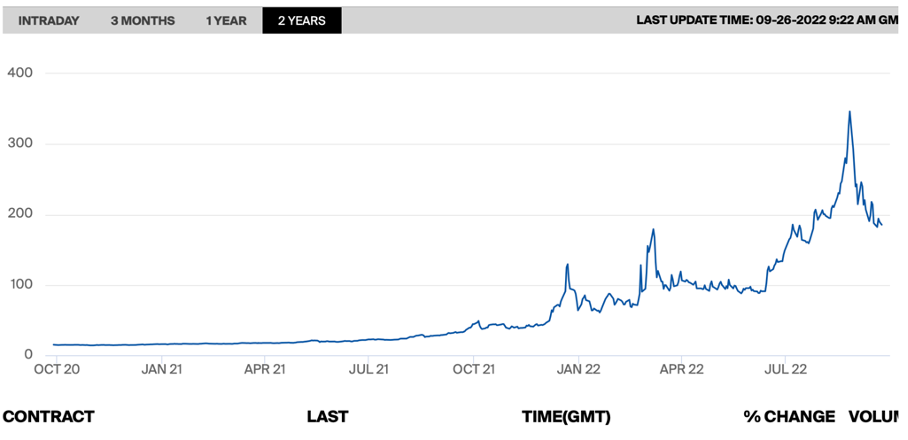Znižanje cen se pričakuje zaradi izgradnje evropskih terminalov za utekočinjeni zemeljski plin (LNG). Glede na študijo Inštituta za energetsko ekonomiko Univerze v Kölnu (EWI), ki jo je naročilo nemško plinsko združenje Zukunft Gas, bi bilo znižanje cen realno že leta 2024, cene pa bi lahko dosegle raven, primerljivo z letom 2018, približno do leta 2026, če bi bila Rusija vsaj delno vključena v trgovanje.
Zmanjšanje odvisnosti od Rusije
Ni skrivnost, da se Evropa želi znebiti sedanje odvisnosti od plina iz Rusije, tudi prek ZDA. V študiji je ocenjeno, da bi lahko do leta 2030 postala največji dobavitelj EU. Po podatkih EWI so evropske države lani od 361 milijard kubičnih metrov plina iz Rusije prevzele kar 147 milijard, iz Norveške 82 milijard in iz ZDA 22 milijard. V primeru, da Rusija na koncu ne bo vključena v odjem v EU, bi lahko količina uvoženega plina iz ZDA že leta 2026 znašala približno 130 milijard kubičnih metrov. Vendar bi moral biti pomen Katarja, s katerim se evropske države trenutno pogajajo, po rezultatih inštituta omejen.
Brez Rusije se bodo cene zvišale
EWI ne pričakuje, da se bodo veleprodajne cene plina v severni Evropi vrnile na raven iz leta 2018, ko so bile v nizozemskem trgovskem vozlišču Title Transfer Facility (TFF) v povprečju najnižje v zadnjih 20 letih, če bo Rusija v celoti izključena iz trgovanja. Če bi se zgodil ta scenarij, družba EWI pričakuje, da se bodo cene vrnile na raven iz leta 2021 do leta 2026 v primeru nizkega povpraševanja in do leta 2030 v primeru visokega povpraševanja. "Toda ob globalno padajočem povpraševanju lahko raven cen iz leta 2018 dosežemo do leta 2030 tudi brez ruskega plina," je na novinarski konferenci dejal vodja združenja Timm Kehler.
Uničenje cen
Pri poenotenju cen plina v Evropi in Aziji naj bi pomagala hitra gradnja terminalov za utekočinjeni zemeljski plin v Evropi, je še dejal Kehler. Po podatkih TFF je raven cen v letu 2018 znašala 24 EUR na megavatno uro, v letu 2021 pa 54 EUR na megavatno uro, ko je bilo celoletno povprečje najvišje v zadnjih 2O letih. Evropske države so začele graditi terminale za utekočinjeni zemeljski plin zaradi negotovosti dobave iz Rusije po izbruhu vojne v Ukrajini in posledičnih sankcijah zahodnih držav proti ruski velesili. Medtem ko je leta 2021 dobava plina po plinovodih v EU predstavljala 75 odstotkov, bi se lahko v prihodnosti zmanjšala na 40 odstotkov.
Tudi gibanje cen
Tudi cena terminske pogodbe za dobavo oktobra 2022 po podatkih TTF trenutno znaša približno 185 evrov na megavatno uro. Za primerjavo, avgusta je znašala 346 EUR na megavatno uro.*

Razvoj vrednosti terminske pogodbe v zadnjih dveh letih. (Vir: Theice.com)
Realnost je lahko drugačna
Tudi je treba opozoriti, da je inštitut v svoji študiji preučil različne možne scenarije z visokim in nizkim povpraševanjem po plinu ter s polno, delno ali nikakršno udeležbo Rusije v evropskem trgovanju. Zato je treba upoštevati, da gre le za modelne situacije, katerih dejanski razvoj bo na koncu odvisen od dejanskega razvoja cen, povpraševanja in uvoznih zmogljivosti.
Olivia Lacenova, analitičarka družbe Wonderinterest trading Ltd.
* Pretekli rezultati niso zagotovilo za prihodnje rezultate.